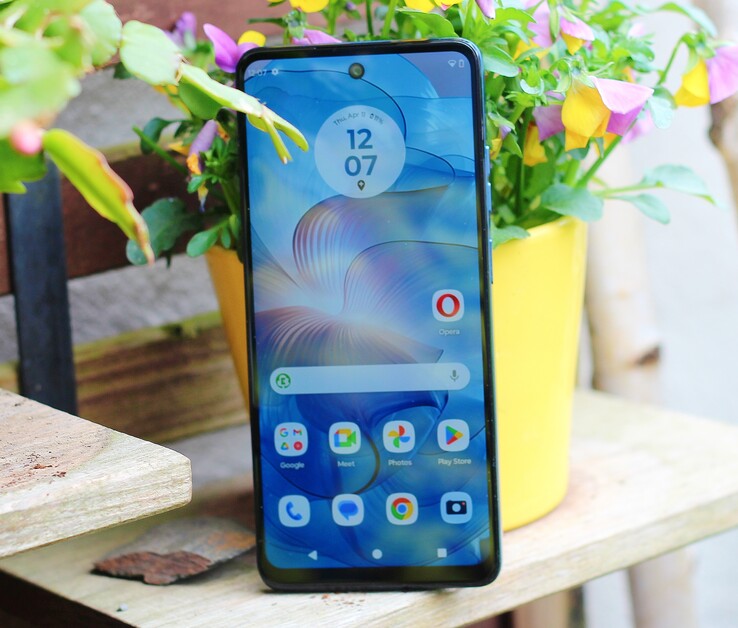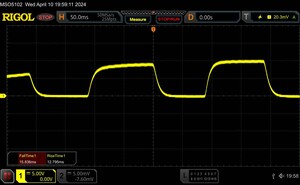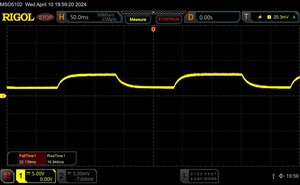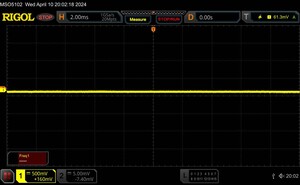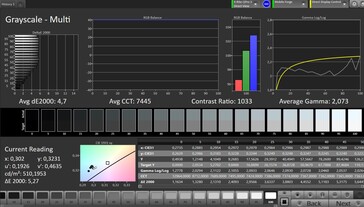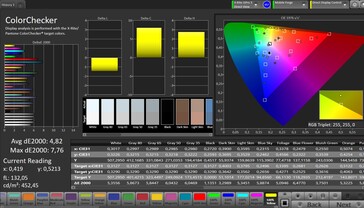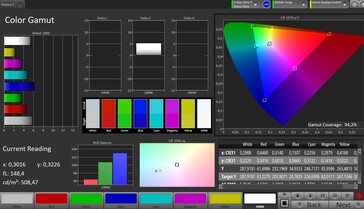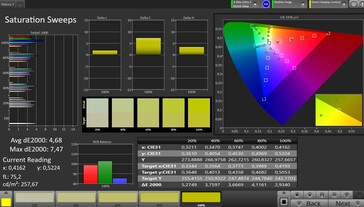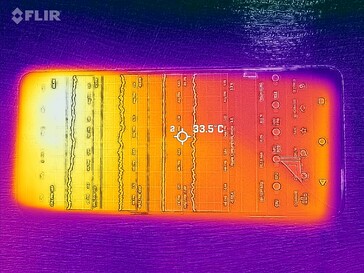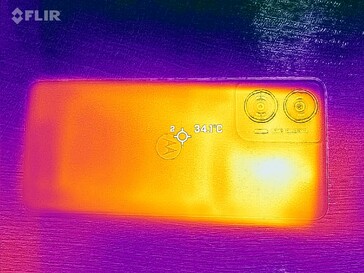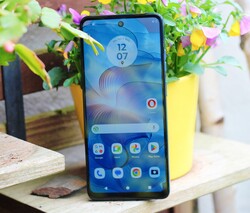Motorola Moto G24 Power review – An affordable phone with long battery life
Comparison with possible competitors
Bewertung | Datum | Modell | Gewicht | Laufwerk | Groesse | Aufloesung | Preis ab |
|---|---|---|---|---|---|---|---|
| 79 % | 04/2024 | Motorola Moto G24 Power Helio G85, Mali-G52 MP2 | 197 g | 256 GB eMMC 5.1 Flash | 6.56" | 1612x720 | |
| 80 % | 04/2024 | Samsung Galaxy A15 Helio G99, Mali-G57 MP2 | 200 g | 128 GB UFS 2.2 Flash | 6.50" | 2340x1080 | |
| 80.2 % | 02/2024 | Xiaomi Redmi Note 13 4G SD 685, Adreno 610 | 188.5 g | 128 GB UFS 2.2 Flash | 6.67" | 2400x1080 | |
| 81.9 % | 03/2024 | Motorola Moto G34 SD 695 5G, Adreno 619 | 179 g | 128 GB UFS 2.1 Flash | 6.50" | 1600x720 |
Case and specifications – Well built and not too chunky
Besides the standard Moto G24, Motorola is also offering the G24 Power, a phone that stands out with a larger battery. Today, we’ll be taking a closer look at this device.
There are a few differences between the two phones: the Power model is 1 mm thicker (around 0.04 in) and weighs 16 g more (0.56 oz), but charges twice as fast and has 1,000 mAh more battery capacity.
The chassis, made of matt shimmery plastic, is available in light or dark blue. The slightly protruding camera module at the top left corner is integrated organically into the design with a gently curved transition, which lends the device a highly premium look and feel.
The frame likewise flows seamlessly into the display module, and the fairly thin screen bezel makes the G24 Power look modern. We are impressed by how sturdy the chassis is: twisting the phone doesn’t cause it to creak or anything to move; you likewise have to apply a very strong force to affect the liquid crystal in the display.
The Motorola phone even boast an IP certification, albeit only up to IP52. This means the device is pretty well protected against dust, but can only withstand water drips.
One difference from the Moto G24, which we’ve yet to discuss, is that the Moto G24 Power features 256 GB of storage and 8 GB of RAM, thus offering better specs in this area. The phone costs around €190 (US$195) and is only available with this storage and memory configuration.
The 3.5 mm audio jack lets you plug in a pair of headphones. You can also read tags and make wireless payments using NFC. Besides having two nano-SIM slots, the SIM tray is able to accommodate one microSD card. But you can’t add any eSIM profile on the budget phone.
We tested out the card reader with our reference microSD (Angelbird V60) and found that it delivers good transfer speeds on a par with what we’ve seen from this class of phones. That said, it doesn’t come anywhere close to fully capitalising on the card’s potential.
| SD Card Reader - average JPG Copy Test (av. of 3 runs) | |
| Samsung Galaxy A15 (Angelbird V60) | |
| Motorola Moto G34 (Angelbird V60) | |
| Motorola Moto G24 Power (Angelbird V60) | |
| Average of class Smartphone (12.1 - 77, n=97, last 2 years) | |
| Xiaomi Redmi Note 13 4G (Angelbird V60) | |
Cross Platform Disk Test (CPDT)
Connectivity, software and operation – Android 14 with 3 years of updates
Wi-Fi 5 is the fastest wireless standard supported by the Motorola Moto G24 Power. In a test performed with our reference router (Asus ROG Rapture AXE11000), the smartphone managed to reach usual speeds between 290 and 350 Mbit/s. Transfer rates were also very stable during our testing.
The Moto G24 Power is an LTE phone and, therefore, cannot utilise the fastest cellular standard right now, 5G. Our review unit supports the most essential frequencies for use in central Europe, but nothing more. If you intend to travel further, it’s necessary to check whether the Moto G24 Power can access mobile Internet in the respective countries.
Android 14 comes preinstalled on the phone, and it’s a fairly stock version at that, meaning the user interface has been left untouched by the manufacturer. All special features are instead found in the Moto app. Our review unit received the March 2024 security patches during our review, thus keeping it quite up to date. Motorola even promises to provide security updates every two months until January 2027. It remains to be seen how many new operating system versions the phone will end up getting.
The 90Hz touchscreen is very accurate and reliable to use, even at the edges and corners. The physical volume and power buttons are located on the right of the chassis. There is a fingerprint sensor built into the latter, and it unlocks the phone reliably with a short delay. The phone also offers face recognition for unlocking, but it uses a 2D method and thus not quite as secure.
| Networking | |
| Motorola Moto G24 Power | |
| iperf3 transmit AXE11000 |
|
| iperf3 receive AXE11000 |
|
| Samsung Galaxy A15 | |
| iperf3 transmit AXE11000 |
|
| iperf3 receive AXE11000 |
|
| Xiaomi Redmi Note 13 4G | |
| iperf3 transmit AXE11000 |
|
| iperf3 receive AXE11000 |
|
| Motorola Moto G34 | |
| iperf3 transmit AXE11000 |
|
| iperf3 receive AXE11000 |
|
Cameras – Decent image quality
Motorola has equipped the main shooter with a 50MP Samsung sensor, which usually uses only a quarter of the resolution for photos. This results in effectively larger pixels and thus higher light sensitivity. Photos captured with the camera are quite typical for a phone this price bracket: they have acceptable colours and don’t always have the perfect dynamic range in extremely bright or dark areas. Sharpness in general could also be higher; this is particularly noticeable when you enlarge images or use digital zoom.
Overall, the photos offer a good level of detail, and even the dramatic sky is well rendered in the picture of the surroundings. Sharpness decreases when there is very little light and high contrast, but image brightening is decently handled. That said, the camera is utterly helpless and couldn’t detect anything at 1 lux of illumination without any light source in the image.
The phone is capable of recording videos at up to 1080p and 30 fps. Autofocus is somewhat fast, but sometimes exhibits hunting behaviour during recording.
There is also a macro lens on the back for extremely close-up shots. It has very low resolution of just 2MP but is usable for snapshots.
The 8MP camera on the front takes decent selfies in good lighting. Image brightening could be slightly better, but pictures taken with this camera can be blown up without too much loss in quality.
Image Comparison
Choose a scene and navigate within the first image. One click changes the position on touchscreens. One click on the zoomed-in image opens the original in a new window. The first image shows the scaled photograph of the test device.
Main camera: plantMain camera: surroundingsMain camera: low-light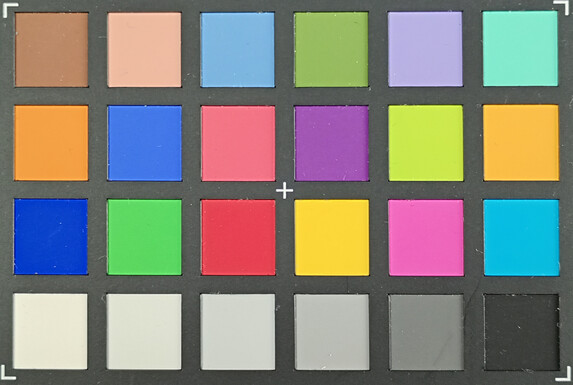

Display – Low pixel count on Moto G24 Power
The IPS display is one area where cost-cutting is evident on the Moto G24 Power: the panel only has a resolution of 1,612 x 720, which is below what many similarly priced devices offer. Moreover, the AMOLED screens on the Samsung Galaxy A15 4G and Xiaomi Redmi Note 13 4G are much brighter, making them more suitable for outdoor use.
Nevertheless, with an average peak brightness of 497 cd/m², the Moto G24 Power’s display is still sufficiently bright for many situations. Unfortunately, black areas on the display also have a somewhat higher brightness, which causes them to appear more greyish and lowers contrast.
We noticed a significant blue tint that imparts a cool hue to the display. You can counteract this to a certain extent using the available settings.
We didn’t detect any PWM flicker. People who are more sensitive to flicker should be able to use the phone without any problems.
| |||||||||||||||||||||||||
Brightness Distribution: 93 %
Center on Battery: 499 cd/m²
Contrast: 1018:1 (Black: 0.49 cd/m²)
ΔE Color 4.82 | 0.5-29.43 Ø5
ΔE Greyscale 4.7 | 0.57-98 Ø5.3
94.2% sRGB (Calman 2D)
Gamma: 2.073
| Motorola Moto G24 Power IPS, 1612x720, 6.56 | Samsung Galaxy A15 Super AMOLED, 2340x1080, 6.50 | Xiaomi Redmi Note 13 4G AMOLED, 2400x1080, 6.67 | Motorola Moto G34 IPS, 1600x720, 6.50 | |
|---|---|---|---|---|
| Response Times | 95% | 94% | -36% | |
| Response Time Grey 50% / Grey 80% * | 39 ? | 2 ? 95% | 2.2 ? 94% | 71.3 ? -83% |
| Response Time Black / White * | 28.6 ? | 1.7 ? 94% | 1.6 ? 94% | 25.5 ? 11% |
| PWM Frequency | 187 | 389.2 | ||
| Screen | 43% | 66% | 20% | |
| Brightness middle | 499 | 731 46% | 940 88% | 523 5% |
| Brightness | 497 | 711 43% | 922 86% | 512 3% |
| Brightness Distribution | 93 | 93 0% | 96 3% | 95 2% |
| Black Level * | 0.49 | 0.47 4% | ||
| Contrast | 1018 | 1113 9% | ||
| Colorchecker dE 2000 * | 4.82 | 2.31 52% | 1.2 75% | 1.89 61% |
| Colorchecker dE 2000 max. * | 7.76 | 3.51 55% | 2.28 71% | 4.63 40% |
| Greyscale dE 2000 * | 4.7 | 1.7 64% | 1.4 70% | 3.1 34% |
| Gamma | 2.073 106% | 2.091 105% | 2.27 97% | 2.262 97% |
| CCT | 7445 87% | 6424 101% | 6503 100% | 6471 100% |
| Total Average (Program / Settings) | 69% /
56% | 80% /
73% | -8% /
9% |
* ... smaller is better
Display Response Times
| ↔ Response Time Black to White | ||
|---|---|---|
| 28.6 ms ... rise ↗ and fall ↘ combined | ↗ 15.8 ms rise | |
| ↘ 12.8 ms fall | ||
| The screen shows relatively slow response rates in our tests and may be too slow for gamers. In comparison, all tested devices range from 0.1 (minimum) to 240 (maximum) ms. » 72 % of all devices are better. This means that the measured response time is worse than the average of all tested devices (21.5 ms). | ||
| ↔ Response Time 50% Grey to 80% Grey | ||
| 39 ms ... rise ↗ and fall ↘ combined | ↗ 22.1 ms rise | |
| ↘ 16.9 ms fall | ||
| The screen shows slow response rates in our tests and will be unsatisfactory for gamers. In comparison, all tested devices range from 0.2 (minimum) to 636 (maximum) ms. » 53 % of all devices are better. This means that the measured response time is worse than the average of all tested devices (33.7 ms). | ||
Screen Flickering / PWM (Pulse-Width Modulation)
| Screen flickering / PWM not detected | |||
In comparison: 53 % of all tested devices do not use PWM to dim the display. If PWM was detected, an average of 17853 (minimum: 5 - maximum: 3846000) Hz was measured. | |||
Performance, emissions and battery life – Stamina as a strength
The performance of the Moto G24 Power is driven by the MediaTek Helio G85 SoC. The phone had a rather disappointing showing in benchmarks: performance-wise, it trails behind many similarly priced devices in our comparison. Though you can mostly navigate through the menus without any hiccups, slightly more demanding tasks are often accompanied by stutters and waiting times.
During web browsing, you may also notice that large websites take quite long to load and images often take time to appear when scrolling. This may well also be due to the slow eMMC flash storage on board, which can’t keep up with any of the storage solutions in the comparison devices as far as speed goes.
Even after extended periods of load, max chassis temperatures remained below 40°C (104°F), which is not a cause for concern. The 3DMark stress tests showed that the SoC didn’t throttle even under prolonged load.
The Moto G24 Power uses a dedicated speaker on the bottom edge and the ear speaker to produce a stereo effect for audio. The speakers are loud enough for a medium-size room. They sound great and are also capable of offering some deep mids, but you shouldn’t expect bass from them. Connecting speakers or headphones over the 3.5 mm jack or Bluetooth will mostly give you an even fuller sound. Many codecs are available for wireless audio, including hi-res options and more exotic ones such as Opus and LHDC.
The 6,000 mAh battery is being marketed as one of the highlight features of the Moto G24 Power. Rightfully so, as demonstrated by our battery test: with the display at a set brightness, the phone lasted a very impressive 18h 23min when used for web browsing over Wi-Fi and beat all the other devices in our comparison by a considerable margin. Since the phone can be charged at up to 30 watts, it takes no more than roughly two hours to fully recharge the battery.
| Motorola Moto G24 Power | Samsung Galaxy A15 | Xiaomi Redmi Note 13 4G | Motorola Moto G34 | Average 256 GB eMMC 5.1 Flash | Average of class Smartphone | |
|---|---|---|---|---|---|---|
| AndroBench 3-5 | 150% | 142% | 90% | -13% | 275% | |
| Sequential Read 256KB | 297 | 967.8 226% | 909.8 206% | 524.1 76% | 266 ? -10% | 1517 ? 411% |
| Sequential Write 256KB | 253.2 | 488.5 93% | 606.3 139% | 495 95% | 239 ? -6% | 1122 ? 343% |
| Random Read 4KB | 100 | 233.2 133% | 177.1 77% | 192.1 92% | 86.2 ? -14% | 248 ? 148% |
| Random Write 4KB | 92.2 | 229.6 149% | 228 147% | 180.2 95% | 73.9 ? -20% | 273 ? 196% |
(+) The maximum temperature on the upper side is 39.6 °C / 103 F, compared to the average of 35 °C / 95 F, ranging from 21.9 to 56 °C for the class Smartphone.
(+) The bottom heats up to a maximum of 38.1 °C / 101 F, compared to the average of 33.8 °C / 93 F
(+) In idle usage, the average temperature for the upper side is 27.2 °C / 81 F, compared to the device average of 32.7 °C / 91 F.
3DMark Wild Life Stress Test
Motorola Moto G24 Power audio analysis
(±) | speaker loudness is average but good (80.5 dB)
Bass 100 - 315 Hz
(-) | nearly no bass - on average 27.3% lower than median
(±) | linearity of bass is average (11.4% delta to prev. frequency)
Mids 400 - 2000 Hz
(+) | balanced mids - only 4.5% away from median
(+) | mids are linear (6.1% delta to prev. frequency)
Highs 2 - 16 kHz
(+) | balanced highs - only 4% away from median
(+) | highs are linear (6% delta to prev. frequency)
Overall 100 - 16.000 Hz
(±) | linearity of overall sound is average (21.4% difference to median)
Compared to same class
» 35% of all tested devices in this class were better, 8% similar, 57% worse
» The best had a delta of 12%, average was 38%, worst was 134%
Compared to all devices tested
» 55% of all tested devices were better, 7% similar, 38% worse
» The best had a delta of 4%, average was 25%, worst was 134%
Motorola Moto G34 audio analysis
(+) | speakers can play relatively loud (83.2 dB)
Bass 100 - 315 Hz
(-) | nearly no bass - on average 34.9% lower than median
(±) | linearity of bass is average (8.3% delta to prev. frequency)
Mids 400 - 2000 Hz
(+) | balanced mids - only 4.7% away from median
(±) | linearity of mids is average (8.8% delta to prev. frequency)
Highs 2 - 16 kHz
(±) | higher highs - on average 7.2% higher than median
(±) | linearity of highs is average (7.5% delta to prev. frequency)
Overall 100 - 16.000 Hz
(±) | linearity of overall sound is average (26.7% difference to median)
Compared to same class
» 63% of all tested devices in this class were better, 7% similar, 30% worse
» The best had a delta of 12%, average was 38%, worst was 134%
Compared to all devices tested
» 79% of all tested devices were better, 4% similar, 17% worse
» The best had a delta of 4%, average was 25%, worst was 134%
| Battery Runtime - WiFi Websurfing | |
| Motorola Moto G24 Power | |
| Motorola Moto G34 | |
| Average of class Smartphone (424 - 2844, n=227, last 2 years) | |
| Samsung Galaxy A15 | |
| Xiaomi Redmi Note 13 4G | |
Pros
Cons
Verdict – Long lasting, but short on performance
There's a lot to like about the Motorola Moto G24 Power: for instance, the stylish chassis with seamless transition between materials, or the large battery that provides long battery life without adding excessive weight or bulk. On top of that, you are also getting stock Android with supposedly three years of security updates, decent speakers, a flicker-free display, and charging technology that is fast for this class of phone.
The generous storage is likewise a highlight and can even be expanded thanks to the microSD slot. The Moto G24 Power also has NFC on board, which isn't always a given on budget mid-range phones.
That said, the Moto G24 Power may not suit everyone, as its display only has a 720p resolution and offers only modest accuracy in colour reproduction. Cost-cutting measures can be seen in the phone's performance as well: both the processor and storage feel fairly sluggish compared with similarly priced devices.
For under €200 (US$195), the Moto G24 Power offers superb battery life and plenty of storage within a stylish chassis. But the manufacturer has skimped on the display and performance.
Before we go, let's take a look at some alternatives: If you prefer to stick with Motorola, the Moto G34 offers enhanced performance without significantly compromising battery life. The Samsung Galaxy A15 4G offers decent stamina too and features an AMOLED screen to boot.
Price and availability
Motorola Moto G24 Power
-
04/25/2024 v7
Florian Schmitt
Transparency
The present review sample was made available to the author as a loan by the manufacturer or a shop for the purposes of review. The lender had no influence on this review, nor did the manufacturer receive a copy of this review before publication. There was no obligation to publish this review.


 Deutsch
Deutsch English
English Español
Español Français
Français Italiano
Italiano Nederlands
Nederlands Polski
Polski Português
Português Русский
Русский Türkçe
Türkçe Svenska
Svenska Chinese
Chinese Magyar
Magyar